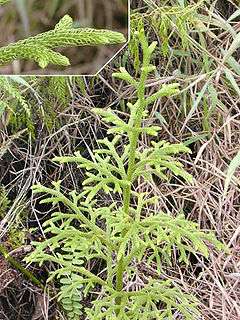Lycopodiopsida
| Clubmosses: Lycopodiopsida | |
|---|---|
 | |
| Lycopodiella cernua with close-up of branch | |
| Scientific classification | |
| Kingdom: | Plantae |
| Division: | Lycopodiophyta |
| Class: | Lycopodiopsida Bartl. 1830[1] |
| Orders | |
| |
Lycopodiopsida is a class of herbaceous vascular plants known as the clubmosses and firmosses. They have dichotomously branching stems bearing simple leaves without ligules and reproduce by means of spores borne in sporangia at the bases of the leaves. Traditionally, the group also included the spikemosses (Selaginella and relatives) and the quillworts (Isoetes and relatives) but because these groups have leaves with ligules and reproduce using spores of two different sizes both are now placed into another class, Isoetopsida that also includes the extinct Lepidodendrales. These groups, together with the horsetails are often referred to informally as fern allies.
The class Lycopodiopsida as interpreted here contains a single living order, the Lycopodiales, and a single extinct order, the Drepanophycales.
Order Lycopodiales
The classification of this group has been unsettled in recent years and a consensus has yet to emerge. Older classifications took a very broad definition of the genus Lycopodium that included virtually all the species of Lycopodiales. The trend in recent years has been to define Lycopodium more narrowly and to classify the other species into several genera, an arrangement that has been supported by both morphological and molecular data and adopted in numerous revisions and flora treatments. Starting from the four genera accepted by Øllgaard,[2] a study based on chloroplast DNA produced the cladogram shown below (reproduced here to genus level only),[3] confirming the monophyly of the four genera, and their distance from Isoetes.
| |||||||||||||||||||||||||
The genera fall into two distinct clades, but there is, as yet, no consensus as to whether to recognize them in a single family, Lycopodiaceae, or to separate them into two families: a more narrowly defined Lycopodiaceae and Huperziaceae.
The family Lycopodiaceae, as narrowly defined, comprises the extant genus, Lycopodium, which includes the wolf's-foot clubmoss, Lycopodium clavatum, ground-pine, Lycopodium obscurum, southern ground-cedar, Lycopodium digitatum, and other species. Also included are species of Lycopodiella, such as the bog clubmoss, Lycopodiella inundata. Most of the Lycopodium species favor acidic, sandy, upland sites, whereas most of the Lycopodiella favor acidic, boggy sites.
The other major group, the family Huperziaceae, are known as the firmosses. This group includes the genus Huperzia, such as the shining firmoss, Huperzia lucidula, the rock firmoss, Huperzia porophila, and the northern firmoss, Huperzia selago. This group also includes the odd, tuberous Australasian plant Phylloglossum, which was, until recently, thought to be only remotely related to the clubmosses. However, as the cladogram above shows, it is closely related to the genus Huperzia.
Lycopodium powder, the dried spores of the common clubmoss, was used in Victorian theater to produce flame-effects. A blown cloud of spores burned rapidly and brightly, but with little heat. It was considered safe by the standards of the time.
See also
- Spikemoss, Selaginella
- Isoetopsida (including quillworts)
References
- 1 2 James L. Reveal, Indices Nominum Supragenericorum Plantarum Vascularium
- ↑ Øllgaard, V. (1987), "A Revised Classification of the Lycopodiaceae s. lat.", Opera Botanica, 92: 153–78, cited in Yatsentyuk et al. 2001
- ↑ Yatsentyuk, S.P.; Valiejo-Roman, K.M.; Samigullin, T.H.; Wilkström, N.; Troitsky, A.V. (2001), "Evolution of Lycopodiaceae Inferred from Spacer Sequencing of Chloroplast rRNA Genes", Russian Journal of Genetics, 37 (9): 1068–73, doi:10.1023/A:1011969716528